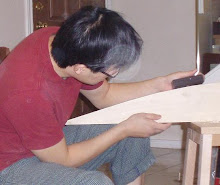
I don't make detail plans because that would require a lot of time and experience. That two things I don't have enough of. That's why many amateur woodworkers buy project plans, all the unexpected problems are exposed by the designers, this makes the craft very predictable (boring).
Encountering the unexpected and solving problems as they arise is one of the joys of designing. I always feet I don't have enough experience to plan things to the finest detail, so following that inexperience to the end of the project just escalate any problems that WILL arise. So, I plan just enough to get started. The priority is not to waste money or wood, have a good function and proportion, but after that, I make things up as it the project progresses. This also gives me a chance to go into my scrap wood pile and make use of it somewhere in the project.
 This is one of my first project, a cabinet loosely based on the traditional Japanese step tansu. I created the usual sketches and thought about how it would look for a while. While assembling the cabinet, I realized I had made a measurement error where the top was ¾ inch narrower than the bottom, resulting in a slight trapezoidal shape of the main box. I planned the project from one sheet of plywood, so there's not enough wood to remake the top. I decided to live with the mistake and trimmed the two doors to fit the now unsquare box. The surprising result was that the pair became self-closing doors because they tilt inward. By creating an equal reveal around the door, most people can't see the error. I then decided to short cut the project and put my tool box on top of the cabinet to get the step tansu look. It now sits next to my entry as a shoe cabinet and a place to put my keys and wallet upon entry to the home.
This is one of my first project, a cabinet loosely based on the traditional Japanese step tansu. I created the usual sketches and thought about how it would look for a while. While assembling the cabinet, I realized I had made a measurement error where the top was ¾ inch narrower than the bottom, resulting in a slight trapezoidal shape of the main box. I planned the project from one sheet of plywood, so there's not enough wood to remake the top. I decided to live with the mistake and trimmed the two doors to fit the now unsquare box. The surprising result was that the pair became self-closing doors because they tilt inward. By creating an equal reveal around the door, most people can't see the error. I then decided to short cut the project and put my tool box on top of the cabinet to get the step tansu look. It now sits next to my entry as a shoe cabinet and a place to put my keys and wallet upon entry to the home.






No comments:
Post a Comment